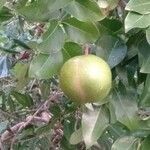Tree usually 4–12 m tall with usually solitary bole to 80 cm diam. and neither buttresses nor pneumatophores; bark lenticellate to finely fissured, greyish. Leaf rachis and petiole to 22 cm long with terminal spike 1 mm long. Leaflets 2–4 pairs, ovate to cordate, sometimes subfalcate, usually 5–10 cm long, 3–5 cm wide, broadly cuneate to cordate and asymmetric at base, acute to acuminate at apex; venation conspicuous; petiolules usually 1–3 mm long. Thyrses usually 10–18 cm long, lax, pendent; main axis distinct; lateral branches to 8 cm long; bracts and bracteoles persistent. Pseudopedicels 3–8 mm long, not conspicuously swollen beneath calyx lobes. Calyx lobes 1–1.5 mm long. Petals elliptic-oblong, 3.5–6 mm long, 2–2.5 mm wide, creamy white. Staminal tube 2–2.5 mm diam.; marginal lobes apiculate or bifid to retuse. Capsule globose, 6–8 cm diam. Seeds 6–16, 3.6–7 cm long; first leaves compound.
A small tree. It grows 4-12 m tall. The roots clasp large boulders on the rocky shore. The fruit are 8-10 cm across. They contain 5-20 seeds.


